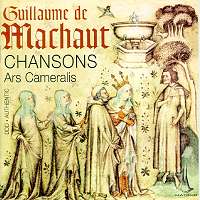|

THE FLOWER AMONG FLOWERS

PETER ASTON explores the music of Guillaume de Machaut
The poet and composer Guillaume de Machaut is the dominant figure in 14th-century French
music. His secular songs form the first great repertory of polyphonic chansons, and
though he also composed for the church (his celebrated Messe de Nostre Dame is the
first complete setting of the Ordinary of the Mass by a single composer) he concentrated
principally on lyric song for the entertainment of the various royal courts which he served
in a secretarial capacity while also holding a number of ecclesiastical benefices,
eventually becoming canon of Rheims.
Machaut's work survives in seven great manuscripts which were assembled under his
supervision towards the end of his life. Several pieces also occur in other sources,
some dating from after the composer's death in 1377. The problem for the modern performer is in
deciding what the notations were intended to represent: rhythmic relationships are often
ambiguous, and in the polyphonic works there is no indication of instrumentation.
 The pieces included in this
recording have all been newly edited by the musical
director of Ars Cameralis, Lukás Matousek. Parts without text are played on a
variety of wind, string and keyboard instruments chosen from those mentioned by Machaut
in his writings. The result is a fascinating array of delicate instrumental colours. The
playing is superb. The pieces included in this
recording have all been newly edited by the musical
director of Ars Cameralis, Lukás Matousek. Parts without text are played on a
variety of wind, string and keyboard instruments chosen from those mentioned by Machaut
in his writings. The result is a fascinating array of delicate instrumental colours. The
playing is superb.
Of the four singers, the most impressive are the three guest performers, one of whom
appears as both counter-tenor and tenor, excelling more with his tenor voice than as a
falsettist. The men are well matched, blending well with the instruments and with each
other. The mezzo-soprano, as a regular member of the ensemble, is understandably given
the lion's share of the vocal work. This is a pity because her diction is poor (words
are barely intelligible even in pieces with a single text and a minimum of hocketing)
and her tone production breathy. There is, of course, no means of knowing how the singing
voice, male or female, was produced in Machaut's day, but the inconsistency between this
singer's chest register and her upper register is distinctly at odds with the uniformity
of tone produced by most instruments of the period throughout their compasses.
Continue >>
Copyright © 8 April 2000 Peter Aston,
Norwich, UK
 INFORMATION - MATOUS MK 0027 2 931
PURCHASE FROM CROTCHET
<< Music &
Vision homepage Bach in good hands >>
INFORMATION - MATOUS MK 0027 2 931
PURCHASE FROM CROTCHET
<< Music &
Vision homepage Bach in good hands >>
 |
To listen to the aural illustrations in this review,
you may need to download RealNetworks' realplayer G2. |
|